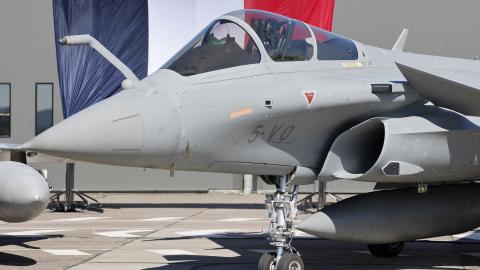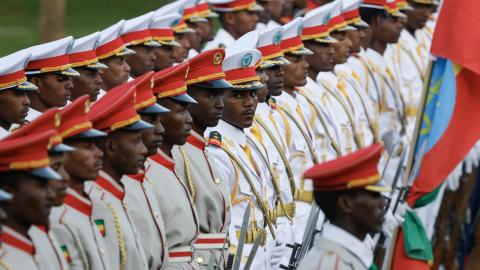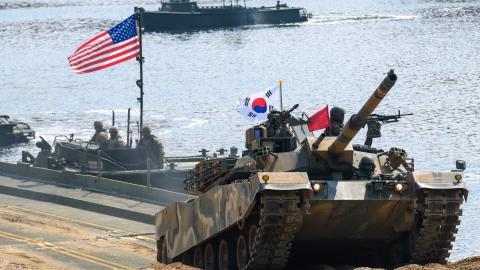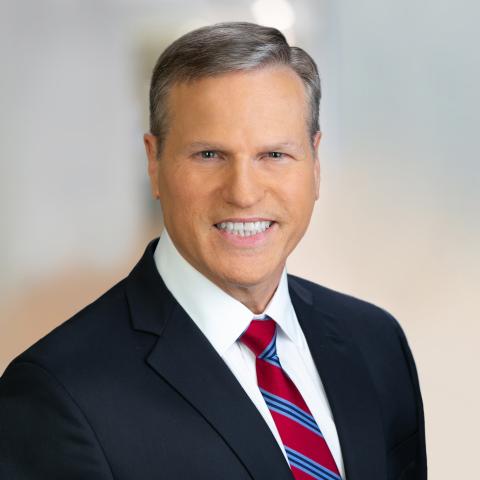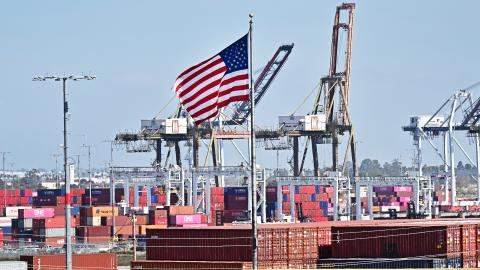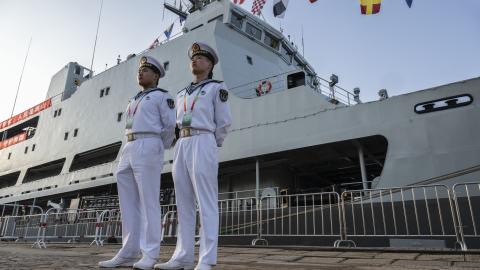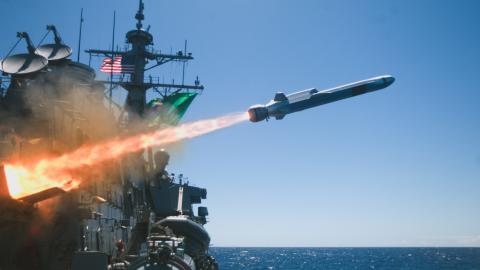Recently, I found myself going through some materials about President Richard Nixon—books and copies of old speeches. I reached for one of his post-presidency books, 1999: Victory Without War, and a picture slipped out. It was a snapshot from a dinner that I had attended at his home in Wood Cliff Lake, New Jersey. He had graciously hosted the interns who had worked on the book.
The evening had begun in his library, which was just what one would imagine, filled with leather chairs, dark mahogany, and bookshelves overflowing with works of history. After appetizers, we were ushered into the dining room. It was my first “professional” dinner. The conversation was substantive: slightly formal but flowing. The former president asked us questions and seemed genuinely interested in what the twenty-somethings around the table thought, even though we didn’t know much about how the world worked.
We discussed the Strategic Defense Initiative, the START I treaty, which was then being negotiated, and Mikhail Gorbachev’s leadership of the Soviet Union.
As I continued to think about that evening, I reread his 1970 First Annual Report on U.S. Foreign Policy and realized that this month marks over a half-century since its delivery to Congress. The report, striking in clarity and realism, is remarkably relevant to today’s geopolitical environment. As the new administration gets underway, it’s worth considering the parallels.
A Structure for Peace
Nixon entered the White House as the world was undergoing a fundamental reordering. In his first report to Congress, he observed that the pattern of international politics was changing. As he saw it, the challenge of statesmanship was to understand the nature of that change, define America’s goals as it unfolded, and set policies to achieve them.
The conditions that had created stability and prosperity after World War II through the 1950s and 1960s were changing. America was still the leading power, but Europe and Japan were growing stronger as they recovered economically, expressing greater self-confidence and political vitality. As Europe’s economic and political confidence grew, European views about the Soviet Union were shifting. Germany’s chancellor, Willy Brandt, was exploring how to make overtures to the Soviet Union. His policy of Ostpolitik sought reconciliation with Moscow to manage tensions, allow more fruitful exchanges between East and West Germany, and set the stage for eventual German reunification.
By 1970, the nuclear balance had also shifted. The United States no longer held strategic superiority vis-à-vis the USSR. Both Washington and Moscow now could inflict “unacceptable damage on the other.” In addition, China was developing its nuclear arsenal. These shifts and the corresponding “revolution in the technology of war,” as Nixon observed, had altered the military balance of power.
Europe’s growing economic strength, Berlin’s outreach to Moscow, and the evolving nuclear landscape brought new challenges for the North Atlantic Treaty Organization (NATO). Nixon, addressing these challenges, invoked the former British prime minister Harold MacMillan’s observation that alliances were held together not by love but by fear.
Nixon also identified the cracks in what, up until then, had been a monolithic Communist bloc, observing, “the Marxist dream of international communist unity has disintegrated.” As the 1960s unfolded, the Soviet Union and Communist China had become adversaries. (Some of the name-calling was intense: Soviet Premier Nikita Khrushchev had called China’s Mao Zedong an “ultra-leftist, ultra-dogmatist, left revisionist, a Buddha who gets theory out of his nose, oblivious to any interests other than his own.”)
Together, these political and military developments represented geopolitical shifts that Nixon believed could be shaped to achieve a “durable peace.” He saw peace as a process “embodied in a structure,” understood that the status quo was changing, and wanted to ensure that the United States led those changes.
In his view, Washington needed to play a key role in maintaining an equilibrium in the world—a balance of power—so that its adversaries would not prevail. Nixon believed that peace was not static; keeping it required constant calibration as other powers acted in their interests.
This belief in a continuing process for maintaining peace was a theme throughout his years in the White House, as well as after he left office. He captured the point eloquently in his book Real Peace:
Real peace will not come from some magic formula that will suddenly and once and for all be “discovered,” like the promised land or the holy grail. Real peace is a process—a continuing process for managing and containing conflict between competing nations, competing systems, and competing international ambitions. Peace is not an end to conflict but rather a means of living with conflict. Once established, it requires constant attention, or it will not survive.
Conditions For Peace
Nixon identified three conditions for maintaining a durable peace in the face of constant geopolitical shifts.
First, Nixon believed that sustaining peace required sharing responsibility. Partnerships have obligations as well as benefits, and both should be shared. He observed that America’s quintessentially “do it yourself” spirit and “healthy impatience” could lead to the tendency of “doing it all” in our foreign policy.
This call for shared responsibility did not mean that peace would be achieved “by giving up our friends or letting down our allies.” Nixon believed that the United States needed to maintain its commitments but advocated for more “responsible participation by our foreign friends” in their defense. This would make it easier for Washington to sustain commitments over the “long pull,” as he put it.
Over time, this idea would become known as the Nixon Doctrine: the United States would participate in the defense and development of its allies and friends but could not and would not “conceive of all.” A threatened nation would shoulder the primary responsibility of providing the manpower for its defense.
Second, Nixon believed that maintaining a durable peace required strength (this was Nixon’s formulation first, not Reagan’s). He believed that American weakness would invite aggression, which could lead to costly miscalculations. He sought to cultivate a world in which “the United States is powerful,” because it would be a “safer world and better world if we have a strong, healthy United States, Europe, Soviet Union, China, Japan, each balancing the other, not playing one against the other, an even balance.”
Third, peace requires a willingness to negotiate. Negotiations, as Nixon saw them, did not indicate weakness, nor were they an end in themselves. The concept of linkage was central to Nixon’s negotiating style. At one point, in planning for the May 1972 Soviet Summit, during which the Strategic Arms Limitation Treaty (SALT) was to be signed, Nixon made it clear that the summit itself could not be the primary consideration. He was, for example, willing to see the summit canceled if the Soviets objected to the strong U.S. response to North Vietnam’s aggression in the spring of 1972.
Nixon’s particular skill involved connecting problems across the military, political, and strategic domains. While he was willing to conduct strategic arms negotiations with the USSR, he expected progress in other areas, like Vietnam or the Middle East. At the time, Henry Kissinger, who served as national security advisor and secretary of state in the Nixon administration, explained to The New York Times that the president wanted to deal with the “problem of peace on the entire front on which peace was challenged and not only on nuclear arms talks.”
These three “instruments” of peace—shared responsibility, strength, and negotiations—would help the United States maintain an equilibrium of power during Richard Nixon’s years in the White House. It was such a balance that provided the most effective bulwark against future war.
“The Perils Of The Present, The Promise Of The Future”
The new Trump administration is well aware of the reordering taking place in the world today. In 2016, Trump was elected on a promise to shape some of these realignments, to restore American strength, and to protect and grow American advantages.
He advanced policies intended to shift the country away from the interdependencies of globalization, particularly reliance on China. Beijing’s unfair trade practices and control over critical supply chains had resulted in negative economic conditions for the American people and degraded their security. Open borders empowered drug cartels and abetted the flow of narcotics into the United States, killing tens of thousands of Americans each year. Radical Islam continued to pose a threat at home and abroad.
Today, these efforts remain unfinished. Trump won reelection in 2024 partly because Americans believed that the shifts that Trump had started to address and manage needed to be completed.
Like Nixon, Trump recognizes how power and its distribution in the world matters. Unlike the Biden administration, Trump does not view displays of power as inherently escalatory. American power can be a tool to shape geopolitical developments around America’s national advantages. Fundamental to both presidents’ worldviews is that states, as individual actors, are the primary sources of both global power and global stability. The U.S. ability to set conditions (as opposed to letting the sprawling international community do so) has set out a fundamentally different course than the Biden administration.
Specific aspects of today’s geopolitical environment are different from those during Nixon’s tenure. The Cold War Sino-Soviet split created an opportunity for Nixon. He took a risk and used U.S. power to divide two adversaries further to retain a balance of power in America’s favor.
Trump will have different opportunities—and, like Nixon, he will see opportunities where others do not. Overall, success in ensuring America’s enduring strengths is more likely if policies align with Nixon’s three conditions for a durable peace.
Trump campaigned on the platform of peace through strength, pledging in his 2025 inaugural address to build “the strongest military the world has ever seen.” As he seeks efficiencies and drives reforms to quickly acquire scalable, lethal forces that take full advantage of America’s technological strengths, deterrence also requires the United States to prove to its adversaries that, if necessary, we can sustain a fight.
He will continue to demand shared responsibility from U.S. allies. He dedicated his first term to cajoling our European partners to build up their militaries and carry their weight within NATO, which led to higher defense spending. Trump does not want a weakened Europe—such a goal would be counterproductive. Instead, he wants independent allies who can meaningfully contribute to opposing anti-Western forces. Europe is divided and stagnating on various fronts. Trump is challenging Europeans to address a status quo characterized by low defense spending, counterproductive net-zero energy policies, and pro-China trade arrangements, while Vice President Vance is reminding them of the values we hold in common.
Like Nixon, Trump will use negotiations to improve American positions in key domains. He will negotiate to achieve the reciprocity that he believes, correctly, is often missing in these areas. Thus, he will continue to drive toward a reordering of the global trading system. This will challenge critics who see his efforts as a tactical “trade war” to acknowledge, instead, that Trump’s use of tariffs and other tools is in pursuit of a more sustainable trading equilibrium.
Trump also likes linkage—a lot. He seems to be able to stretch it to its limits. He had no problem pulling out of the JCPOA in 2018 because the deal isolated the nuclear question and eschewed all linkage to Iran’s chaos-sowing behavior in the Middle East. He imposed maximum pressure through sanctions and linked an easing of sanctions to changes in Iranian behavior across the board.
His announcements of tariffs on Canada and Mexico have led both countries to finally take their border security seriously. This linkage won U.S. neighbors a one-month reprieve, during which tariffs will be further linked to achieving more balanced trade. More tariff- and sanctions-related linkage awaits Russia, Iran, and China.
Trump often takes disruptive approaches to induce others to move in the direction he prefers. His recent proposal to take over Gaza has led to states in the region positioning to rebuild the territory. His assertive posturing on the Panama Canal led its government to move toward his view on China’s role in the canal. A test of linkage now, as negotiations over Ukraine in Riyadh unfold, will be whether or not Trump can help to achieve a stable European theater that is not dominated by Russia and allows the United States to remain active in shaping a balance of power around the world. A Russia that controls Ukraine and its unparalleled resources is not in American interests and sends a provocative signal to China and Iran. U.S. interests span many regions of the world and are linked.
A Playbook For Stability
At that dinner, some thirty years ago, President Nixon reiterated one of the key themes of his book 1999: the importance of maintaining a balance of power to preserve peace.
One of Nixon’s favorite writers was Paul Johnson, whom the former president often quoted. Johnson once wrote, “One of the lessons of history is that no civilization can be taken for granted. Its permanency can never be assured; there is always a dark age waiting for you around the corner if you play our cards badly and make sufficient mistakes.”
As Johnson’s words reflect, Richard Nixon understood how power abhors a vacuum: if the United States does not lead, someone else will. Throughout the many global shifts that occurred during his administration, the thirty-seventh president remained determined to guide America into a sustainable position of power. He was not wedded to establishment approaches to diplomacy and was not afraid to ruffle feathers.
Like Richard Nixon, Donald Trump understands that periods of geopolitical reordering offer generational opportunities to update and reconfigure the world system. The key will be in also appreciating, like Nixon, that peace is not static and that other rivals, if given the opportunity and resources, will grow their power at the expense of ours.
